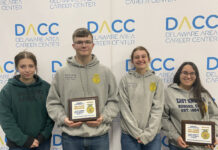Jeff Zellers once intended to go to law school, but in 1987 decided to join the family farm business established by his grandparents in the 1920s. His degree in economics came in handy as help was needed in the sales and marketing areas.
In the last 20 years, the K.W. Zellers and Son Inc. family farm in Hartville, Ohio, has acquired more land as surrounding farms went out of business. Now the farm ships leafy lettuce, radishes, green onions and herbs all over the eastern U.S.
The labor force that harvests the crop, under the field supervision of Jeff’s cousin, David Zellers, is a largely Latino community of over 300 migrant workers and their families.
New book. It is this community that is the focus of both a 192-page book, Growing Season: The Life of a Migrant Community, published in September by Kent State University Press, and an exhibition of the same name at the Canton Museum of Art.
The exhibition, which runs until Oct. 29, features 50 images from the book, along with their related stories. The color images are by award-winning Kent State University photographer Gary Harwood and the text was written by poet and essayist David Hassler, who is program director for the Wick Poetry Center at Kent State University.
When Harwood began his photo documentation of the farm workers in 2001, he thought he would be witnessing the hardships and degradation often associated with migrant labor camps. True enough, the work is inherently exhausting, hot and dirty.
But what Harwood ultimately encountered, however, was a thriving and vibrant community of tight-knit families supported by the Hartville Migrant Center and surrounding population of good neighbors.
Narratives. Hassler began collaborating on the project in 2004. From transcripts of his interviews with both migrants and volunteers at the center, he wrote narratives that speak with the voices of the people themselves.
Ivan Soto, for example, tells us that his father was the first in his family to arrive here from Mexico 10 years ago. Soto taught himself English and followed with the rest of the family three years later. This year his boss gave him his own house next to his parents so he could bring his wife and son, once he gets her a resident card.
He goes on to relate the arduous and moving story of acquiring his own citizenship.
“A lot of people come to the United States illegally,” he said, “but I don’t want to do that for my family. I don’t want to take that way.”
Ivan’s story is not uncommon in this community.
Photos. Harwood’s photographs give more than just a comprehensive look at workers doing their jobs. It is an intimate collection that presents lives lived to the fullest. We see families gathered for baptisms and first communions, weddings and birthdays, and private moments of quiet reflection.
There’s nothing overly precious or contrived about the images. Rather, you get the sense that Harwood’s presence, whether in the fields or in the workers’ homes, was unobtrusive, even friendly and trusted.
What emerged from this collaboration is a compelling and beautiful portrait of a community rarely seen and often misunderstood by the public at large. In the current climate of heated debate on the problem of “alien” workers, it’s easy to view these individuals as mere statistics. But the statistics have voices, histories, families.
Jeff Zellers observes in the book: “Family is very important to our workers … When they arrive, you know they are here and are not leaving until the family is leaving. That is great … There’s a great misconception that when these people come into our country they are actually taking jobs away from citizens. But most of the jobs in agriculture are not going to be done at any pay rate by the remaining people that are unemployed in this country. It is just a plain reality.”
Facts of life. Just as plain, perhaps, as Soto’s dream. For now, his story stops with, “If I can I would like to have a mini-market or something like that. Maybe someday when I’m old, my family can live back in Mexico. But now I am young and I know I have to work here for a lot of years.”
The exhibition will move on to the Butler Institute of American Art in Youngstown from Nov. 19 to Jan. 7.
The book can be purchased at the Canton Museum of Art or it can be ordered online at www.kentstateuniversitypress.com.
Get 4 Weeks of Farm and Dairy Home Delivered









